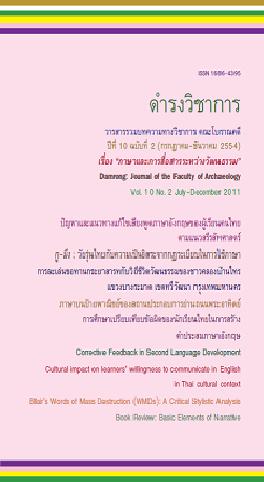CULTURAL IMPACT ON LEARNER'S WILLINGNESS TO COMMUNICATE IN ENGLISH
Keywords:
-Abstract
This paper discusses the Thai cultural influences underlying one’s choice of speaking English in EFL classrooms in Thailand. A conceptualization of the decision to speak in a second language, which was called “Willingness to Communicate in a Second Language” by MacIntyre et al. (1998), was chosen as the foundation of the analysis. The MacIntyre model was principally developed in the bilingual context in Canada, where language resources are abundant, while the reverse is true for Thailand. Given the differences in contextual factors, this paper focuses on relevant components that come in play in different communication situations in Thai EFL classes from Thai cultural perspectives. Traditional Thai values that form ones’ attitudes in interacting with others were examined. The analysis of principles behind Thai social interactions behaviors reveals the power of “others” over oneself when making the choice to speak in English.
References
Cao, Y. & Philp, J. (2006). Interactional context and willingness to communicate: Acomparison of behavior in whole class, group and dyadic interaction.System, 34(4), 480-493.
Gudykunst, W.B. (1998). Individualistic and collectivistic perspectives oncommunication: An introduction. International Journal of InterculturalRelations, 22(2), 107-134.
Hofstede, G. (2001). Culture’s consequences: Comparing values, behaviors,institutions, and organizations across nations. California: Sage.
Holmes, H., Tangtongtavy, S. & Tomizawa, R. (1995). Working with the Thais. Bangkok: White lotus.
Kang, S.J. (2005). Dynamic emergence of situational willingness to communicate ina second language. System, 33(2), 277-292.
Komin, S. (1985). The world view through Thai value systems. In A. Pongsapich et al.,Traditional and changing Thai world view. Bangkok: Chulalongkorn University Press.
Komin, S. (1990). The psychology of Thai people. Bangkok: Research Institute of Development Administration.
MacIntyre, P.D. (1994). Variables underlying willingness to communicate: A causalanalysis. Communication Research Reports, 11(2), 135-142.
MacIntyre, P.D. (2007). Willingness to communicate in the second language:understanding the decision to speak as a volitional process. ModernLanguage Journal, 91(4), 564-576.
MacIntyre, P.D., Baker, S.C., Clément, R. & Donovan, L.A. (2003). Talking in order tolearn: Willingness to communicate and intensive language programs.Canadian Modern Language Review, 59(4), 589-607.
MacIntyre, P.D., Dörnyei, Z., Clément, R. & Noels, K.A. (1998). Conceptualizingwillingness to communicate in a L2: A situational model of L2 confidence andaffiliation. Modern Language Journal, 82(4), 545-562.
McCroskey, J.C. & Richmond, V.P. (1990). Willingness to communicate: A cognitiveview. In M. Booth-Butterfield (Ed.), Communication, cognition, andanxiety. Thousand Oaks, CA: Sage.
McCroskey. (1997). Willingness to communicate, communication apprehension,and self-perceived communication competence: Conceptualizationsand perspectives. In J.A. Daly & J.C. McCroskey (Eds.), Avoidingcommunication: Shyness, reticence, and communication apprehension. Cresskill, NJ: Hampton Press.
Mulders, N. (1979). Everyday life in Thailand: An interpretation. Bangkok: Duang Kamol.
Mulders, N. (1996). Inside Thai society: Interpretations of everyday life.Amsterdam: Pepin Press.
Pattapong, K. (2010). Willingness to communicate in a second language: A qualitativestudy of issues affecting Thai EFL learners from students’ and teachers’points of view. Unpublished Ph.D. thesis, The University of Sydney, Australia.Peng, J.E. (2007). Willingness to communicate in the Chinese EFLclassroom: A cultural perspective. In L.J. (Ed.), English language teachingin China: New approaches, perspectives, and standards. NY: Continuum.
Senawong, P. (1999). Developing pragmatic competence for cross-cultural communication. In English is an Asian language: The Thai context.Sydney: Macquarie Library.
Sensenig, B. (1975). Socialization and personality in Thailand. In K. Ishwaran (Ed.),Contributions to Asian studies (Vol. The psychological study of Theravadasocieties). E.J. Brill: Leiden.
Triandis, H.C. (1995). Individualism and collectivism. Boulder, CO: Westview Press.
Ushioda, E. (2009). A person-in-context relational view of emergent motivation, selfand identity. In D. Zoltán & U. Ema (Eds.), Motivation, language identity, and the L2 self. Bristol: Multilingual Matters.
Wen, W.P., & Clément, R. (2003). A Chinese conceptualization of willingness to communicate in ESL. Language, Culture and Curriculum, 16(1), 18-38.
Wichiajarote, W. (1973). The theory of affiliative society. Bangkok: PrasanmitrCollege of Education.
Downloads
Issue
Section
License
บทความนี้เป็นผลงานของข้าพเจ้าแต่เพียงผู้เดียว และ/หรือเป็นผลงานของข้าพเจ้าและผู้ร่วมงาน ตามชื่อที่ระบุในบทความจริง และเป็นผลงานที่มิได้ถูกนำเสนอหรือตีพิมพ์ที่ใดมาก่อน





